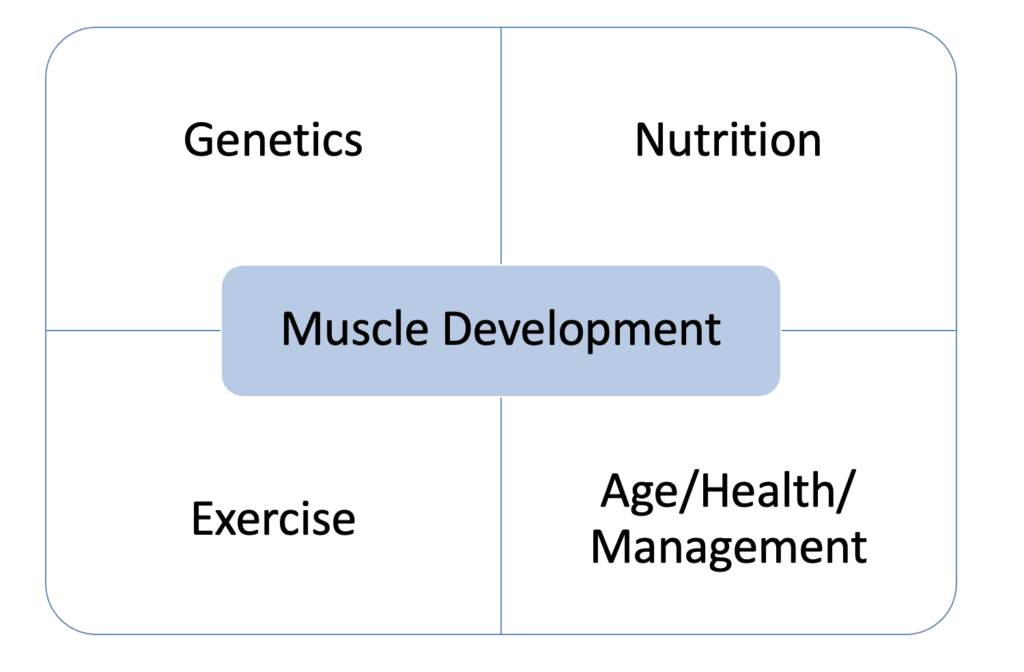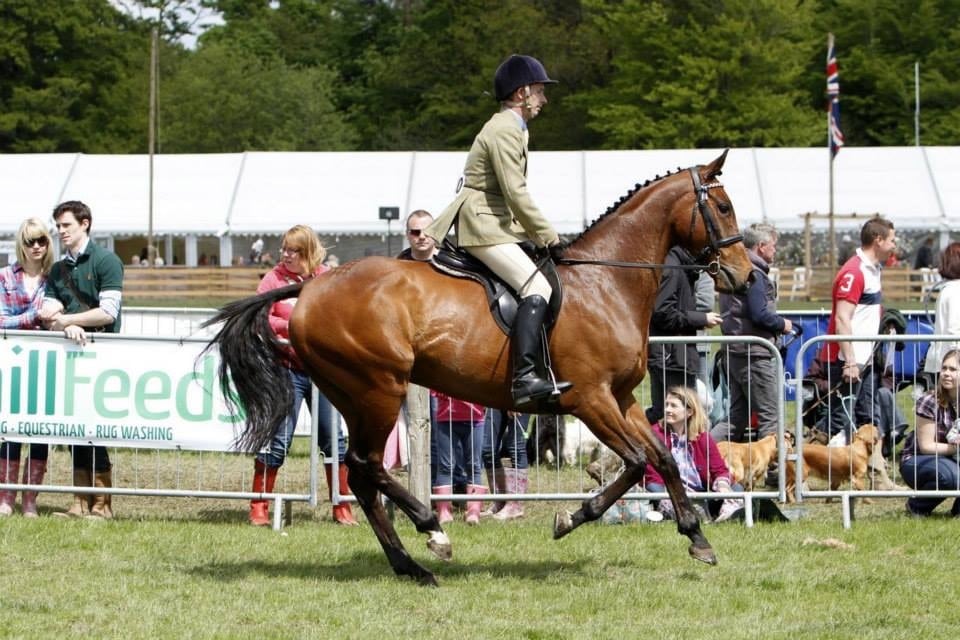Briony Witherow, defines ‘condition’ and outlines how to build muscle
Topline is a term commonly used to describe the muscle over the top of the horse’s neck, back and hindquarters. It can sometimes be confused and even disguised by body fat covering making it difficult to assess.
What is condition?
When it comes to horses, the term condition can have various meanings, so it is always best to check on each occasion. It can refer to body fat covering or muscle or sometimes both! It can also encompass coat, skin as well as general health. For this article we are going to consider the term as referring to muscle and body fat covering, this is because when it comes to nutrition, the two go hand in hand.
Assessing body condition
Assessing body fat covering through body condition scoring is key for two reasons; firstly, body condition (amount of body fat) can disguise muscle¹ (or lack thereof); secondly, sufficient calorie/energy intake is a prerequisite for muscle building
You can use either a 5 or 9-point scale and the assessment should include palpation (feeling over the horse) alongside visual assessment² ³. When feeling for the difference between muscle and fat, muscle tends to be smoother and flatter (and firmer, depending on fitness), whereas fat tends to be softer and more ‘squidgy’, except for when fat has been deposited for a longer period where it will turn firmer. As well as the difference in feel, use your body condition score guide to become familiar with typical fatty deposit areas. If you can practice on horses of different body conditions and fitness, this will help you to become better at discerning the differences (for example, muscle is often more defined and distinctive on a fitter horse).
Remember that the ‘ideal’ body condition score (BCS) should be specific to the individual horse. On a 9-point scale, a 5 would represent a moderate BCS and therefore be appropriate for some horses. However, an ideal BCS for many performance horses would be 4-4.5. An ideal starting point for muscle building is a horse that is lean to moderate in condition, not poor or fat.
Assessing muscle condition
Assessing your horse’s muscle in light of their current workload and management can provide an indication of whether nutritional requirements are being met. Just like using body condition scoring to see if calorie requirements are being met (or indeed exceeded), you can use a muscle assessment to get an idea of whether you are meeting quality protein and energy requirements. An example of a good muscle assessment scale is the Topline Evaluation Score (TES).
A good muscle score guide should provide details of key superficial muscles which you can easily assess by palpating (feeling) with a firm and consistent touch (the same as body condition scoring). For both muscle and body fat assessment, you should use only as much pressure as it takes to move the skin on your forehead.
A common site of confusion between muscle and fat is the crest, the difficulty in distinction made more challenging when longer standing fatty deposits in this region turn firmer. An easy fact to remember can help resolve this misconception; there is a ligament called the nuchal ligament which runs from the poll to the wither – no muscle can be deposited above this point. As such any addition above this point is fat² ³.

How do we build muscle?
As we have already established, muscle development and overall condition are multifaceted in nature meaning we cannot address feeding for muscle, without addressing body condition (fat covering) and therefore energy (calorie) intake. It is important to note that muscle development is not only the result of providing the correct building blocks in the diet, but also appropriate training and exercise (not just how much but what) and other factors such as genetics, health, age, and management.
Assessing the ration
Check that the feed(s) your horse is fed are appropriate for their current workload. Some nutritional requirements (such as protein) increase with workload , so⁴ selecting a feed which states it is appropriate for a set workload is key. Intended use is typically stated on the packaging and literature for a product.
Next, check that your horse is receiving the recommended amount for their size and workload – if you are feeding significantly less than this, it may be worth considering moving down a step to a lower calorie/energy feed.
If you are feeding a suitable feed at the correct rates and feeding average forage (grass/hay/haylage), you should be on track for meeting minimum protein and lysine requirements⁴ ⁵.

Calories and energy are the same thing, and you can assess if you are providing adequate amounts through assessing body condition (body condition scoring). An ideal starting point for muscle building is a horse that is lean to moderate in condition, not poor or fat. Where BCS is not optimal, adjust the ration to increase or decrease total calorie/energy intake.
Following step 1 should ensure that the base ration is providing a good amount of protein, but it may not always ensure that the quality is high. Horses have a requirement for amino acids (‘building blocks’ of protein) rather than crude protein⁴ and therefore, the emphasis should be placed on quality (amino acid profile) rather than quantity (total protein). In the horse’s body, lysine is what is known as the “first limiting amino acid”. This means that protein can only be utilised in accordance with the levels of lysine in the body and therefore any deficiencies in this amino acid will impair protein synthesis. Apart from lysine, individual amino acid requirements are not known for the horse and therefore a balanced diet must be formulated using protein and lysine levels⁴.
Unfortunately, current legislation means that feed companies are only required to declare crude protein on feed labels – this often means that we need to look to the ingredients list to gauge a better idea of likely quality.
Ingredients on a feed label are declared in descending order of inclusion (ingredients at the top included in the greatest quantity). We want to look out for ingredients that provide a good amino acid profile, such as soya bean meal. If this appears near the top of the list, this would be a good indication of protein quality. Whereas something like sunflower meal or cereals like wheat and barley tend to provide lower quality protein.
Details of specific amino acid levels may also be provided on product labelling, but these are at the manufacturer’s discretion or where additional amino acids have been added to improve the profile of a feed. To achieve the latter, feed-grade sources of several individual amino acids may be added, and you would see these listed under additives on the statutory statement (a common example is ‘L-Lysine’).
It is worth noting that protein (including lysine) is also present within forage (hay/haylage/grass), however, the level available may be inconsistent, tending to fluctuate throughout the year where forage source changes⁵.
While protein from forage will contribute to the ration, a proportion of these will be ‘sealed up’ within the fibre and not directly accessible for the purpose of muscle development. Typically, the more fibrous the forage, the lower the level of ‘accessible’ protein. This explains why protein requirement varies throughout the year and with forage type. For example, a horse on spring grass is likely to consume more ‘accessible’ protein than a horse on very mature hay⁵. As a result, we tend to rely on the concentrate ration to provide more consistent quality protein year-round and pick up any shortfall.
Can I feed too much protein?
In practice, it tends to be more common for diets to have too much crude (total) protein that is poor quality (lacking amino acids). As protein cannot be stored by the body, where excess protein is fed (particularly where it is of poor quality) there is no advantage to the horse, the process of excreting the surplus ‘costing’ energy.
Do I need any additional supplements?
Any weaknesses discovered in th ration assessment can either be addressed by tweaking the base ration – for example changing feed type or amount if suboptimal or selecting a feed with a higher lysine content. Alternatively, the ration can be ‘topped up’ with appropriate supplements. While the latter may be less economical, it does provide flexibility and convenience (avoiding a complete ration overhaul).
Supplements formulated to promote muscle and condition may contain individual amino acids and/or a source of calories (typically from fats/oil). More general conditioning supplements tend to be high in oil/fat and help not only add calories but also improve coat condition and shine. Pelleted or extruded versions of high fat products tend to be more palatable than high oil (liquid) products. If opting for high oil/fat-based supplements, as the horse does not have a gall bladder, it can take up to 6 weeks for the digestive system to adapt and therefore utilise the ingredients to their fullest. Such supplements therefore need to be fed for at least this time to see the benefits.
Specific muscle building supplements will often contain a range of amino acids (the building blocks of protein) sometimes alongside fat/oil. These supplements are typically aiming to provide a concentrated source of highly digestible amino acids and as such can be expensive. Before taking this step, do be sure to eck the base ration and address any other management factors.
Whatever approach you take, a change in overall and muscle condition is takes upwards of 6 weeks, subject to workload. Make use of both body condition and muscle scoring systems to benchmark your progress.
[/ux_text]
Build muscle and top line
Baileys No. 19 Performance Balancer
If you need to build top line without excessive weight gain, this high specification balancer delivers optimum levels of a comprehensive range of important and essential amino acids to help build and repair muscle tissue. It can be fed as the sole concentrate alongside forage to good-doers or, added to reduced quantities of other hard feeds. Its full spectrum of vitamins, minerals and antioxidants also support muscle function and recovery.
References
1. Dugdale, A.H., Curtis, G., Cripps, P.J., Harris, P.A., and Argo, C.M. (2010) Effects of season and body condition onappetite, body mass and body composition in ad libitum fed pony mares. Equine Veterinary Journal, 42 (7): 600-610
2. Henneke, D.R., Potter, G.D., Kreider, J.L., and Yeates, B.F. (1983) Relationship between condition score, physicalmeasurements and body fat percentages in mares. Equine Veterinary Journal, 15:371-372
3. Carroll, C.L., and Huntington, P.J. (1988) Body condition scoring and weight estimation of horses. Equine VeterinaryJournal, 20: 41-45
4. NRC, (2007) Nutrient requirements of Horses, Sixth edition. National Academies Press: Washington, DC.
5. Equi-analytical laboratories. (2022) Common feed Profiles. [Online]. [Accessed 10th June 2022]. Available from: https://equi-analytical.com/common-feed-profiles/




